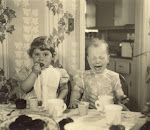The Valentines and McNallys lived in the
Fort Greene/Clinton Hill section of Brooklyn,
to the south and east of Fort Green Park.
The neighborhood seems to have extended from Myrtle Avenue on the North down to Greene Avenue on the South, probably defined by the church (the green star on the map), Queen of All Saints at 300 Vanderbilt, on the corner of Lafayette.
Queen of All Saints in 1928
Adelphi Street
Bambi's records of who lived where and when include many addresses on Adelphi Street, 2 blocks west of Vanderbilt.
Composite of Adelphi Street near Myrtle
photographed in the 1940s
from the NY Public Library Collection
A few addresses:
93 Adelphi, Patrick McNally and wife here in 1910 census (the numbers start on the north end of the street)
157 Adelphi, William Valentine and Cecelia here in 1910 census
163 Adelphi
163 Adelphi, Wm McNally and family here in 1910 with Anna's parents Elizabeth and John Valentine
206 Adelphi
206 Adelphi, William and CeceliaValentine lived here on 1912 birth certificate. The house, a fixer-upper built in 1899, is now for sale at about $900,000.
Apparently all the odd numbers in the 200 block
of Adelphi (south of Willoughby Avenue) are gone now, replaced by
the Clinton Hill School (PS #20) at 225 Adelphi
223 Adelphi, Curleys here at Bess's death in 1940 w/ Eliz & John Valentine
225 Adelphi, Curleys here in 1920
227 Adelphi, Wm McNally and family here in 1920
Corner of Adelphi and Willoughby today
Clermont Avenue
Clermont Avenue is one block west of Adelphi
77 Clermont, William and CeceliaValentine here in 1908 on birth certificate
An apartment in 271 Clermont is currently for rent for $4,000 a month
271 Clermont, John Valentine dies living here in 1922
Cumberland Street
Cumberland Street runs right along the park.
39 Cumberland, John Valentine Jr. living here 1917 draft
134 Cumberland, Patrick McNally (Grandpa's brother) living here in 1900
DeKalb Avenue
DeKalb is/was a major business street.
203 DeKalb, Scully Funeral Home – Eliz. Valentine buried from here in 1951
Myrtle Avenue
270 Myrtle, William and Cecelia Valentine living here 1909 birth certificate
370 Myrtle, William and Cecelia Valentine living here 1910 and 1918 draft
Vanderbilt Avenue
300 Vanderbilt, Queen of All Saints Church and Elementary School – at Lafayette
Links to neighborhood pictures:
http://www.bridgeandtunnelclub.com/bigmap/brooklyn/fortgreene/walk/index.htm









































